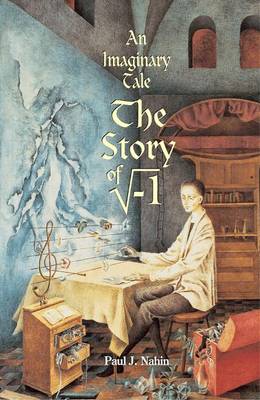Princeton Science Library
3 total works
I used to think math was no fun 'Cause I couldn't see how it was done Now Euler's my hero For I now see why zero Equals e[pi] i+1 --Paul Nahin, electrical engineer In the mid-eighteenth century, Swiss-born mathematician Leonhard Euler developed a formula so innovative and complex that it continues to inspire research, discussion, and even the occasional limerick. Dr. Euler's Fabulous Formula shares the fascinating story of this groundbreaking formula--long regarded as the gold standard for mathematical beauty--and shows why it still lies at the heart of complex number theory. This book is the sequel to Paul Nahin's An Imaginary Tale: The Story of I [the square root of -1], which chronicled the events leading up to the discovery of one of mathematics' most elusive numbers, the square root of minus one. Unlike the earlier book, which devoted a significant amount of space to the historical development of complex numbers, Dr. Euler begins with discussions of many sophisticated applications of complex numbers in pure and applied mathematics, and to electronic technology.
The topics covered span a huge range, from a never-before-told tale of an encounter between the famous mathematician G. H. Hardy and the physicist Arthur Schuster, to a discussion of the theoretical basis for single-sideband AM radio, to the design of chase-and-escape problems. The book is accessible to any reader with the equivalent of the first two years of college mathematics (calculus and differential equations), and it promises to inspire new applications for years to come. Or as Nahin writes in the book's preface: To mathematicians ten thousand years hence, "Euler's formula will still be beautiful and stunning and untarnished by time."
The topics covered span a huge range, from a never-before-told tale of an encounter between the famous mathematician G. H. Hardy and the physicist Arthur Schuster, to a discussion of the theoretical basis for single-sideband AM radio, to the design of chase-and-escape problems. The book is accessible to any reader with the equivalent of the first two years of college mathematics (calculus and differential equations), and it promises to inspire new applications for years to come. Or as Nahin writes in the book's preface: To mathematicians ten thousand years hence, "Euler's formula will still be beautiful and stunning and untarnished by time."
What is the best way to photograph a speeding bullet? Why does light move through glass in the least amount of time possible? How can lost hikers find their way out of a forest? What will rainbows look like in the future? Why do soap bubbles have a shape that gives them the least area? By combining the mathematical history of extrema with contemporary examples, Paul J. Nahin answers these intriguing questions and more in this engaging and witty volume. He shows how life often works at the extremes - with values becoming as small (or as large) as possible - and how mathematicians over the centuries have struggled to calculate these problems of minima and maxima. From medieval writings to the development of modern calculus to the current field of optimization, Nahin tells the story of Dido's problem, Fermat and Descartes, Torricelli, Bishop Berkeley, Goldschmidt, and more. Along the way, he explores how to build the shortest bridge possible between two towns, how to shop for garbage bags, how to vary speed during a race, and how to make the perfect basketball shot.
Written in a conversational tone and requiring only an early undergraduate level of mathematical knowledge, "When Least Is Best" is full of fascinating examples and ready-to-try-at-home experiments. This is the first book on optimization written for a wide audience, and math enthusiasts of all backgrounds will delight in its lively topics.
Written in a conversational tone and requiring only an early undergraduate level of mathematical knowledge, "When Least Is Best" is full of fascinating examples and ready-to-try-at-home experiments. This is the first book on optimization written for a wide audience, and math enthusiasts of all backgrounds will delight in its lively topics.
Today complex numbers have such widespread practical use - from electrical engineering to aeronautics - that few people would expect the story behind their derivation to be filled with adventure and enigma. In "An Imaginary Tale", Paul Nahin tells the 2000-year-old history of one of mathematics' most elusive numbers, the square root of minus one, also known as 'i'. He recreates the baffling mathematical problems that conjured it up, and the colorful characters who tried to solve them. In 1878, when two brothers stole a mathematical papyrus from the ancient Egyptian burial site in the Valley of Kings, they led scholars to the earliest known occurrence of the square root of a negative number. The papyrus offered a specific numerical example of how to calculate the volume of a truncated square pyramid, which implied the need for 'i'. In the first century, the mathematician-engineer Heron of Alexandria encountered 'i' in a separate project, but fudged the arithmetic; medieval mathematicians stumbled upon the concept while grappling with the meaning of negative numbers, but dismissed their square roots as nonsense.
By the time of Descartes, a theoretical use for these elusive square roots - now called 'imaginary numbers' - was suspected, but efforts to solve them led to intense, bitter debates. The notorious 'i' finally won acceptance and was put to use in complex analysis and theoretical physics in Napoleonic times. Addressing readers with both a general and scholarly interest in mathematics, Nahin weaves into this narrative entertaining historical facts and mathematical discussions, including the application of complex numbers and functions to important problems, such as Kepler's laws of planetary motion and AC electrical circuits. This book can be read as an engaging history, almost a biography, of one of the most evasive and pervasive 'numbers' in all of mathematics.
By the time of Descartes, a theoretical use for these elusive square roots - now called 'imaginary numbers' - was suspected, but efforts to solve them led to intense, bitter debates. The notorious 'i' finally won acceptance and was put to use in complex analysis and theoretical physics in Napoleonic times. Addressing readers with both a general and scholarly interest in mathematics, Nahin weaves into this narrative entertaining historical facts and mathematical discussions, including the application of complex numbers and functions to important problems, such as Kepler's laws of planetary motion and AC electrical circuits. This book can be read as an engaging history, almost a biography, of one of the most evasive and pervasive 'numbers' in all of mathematics.


